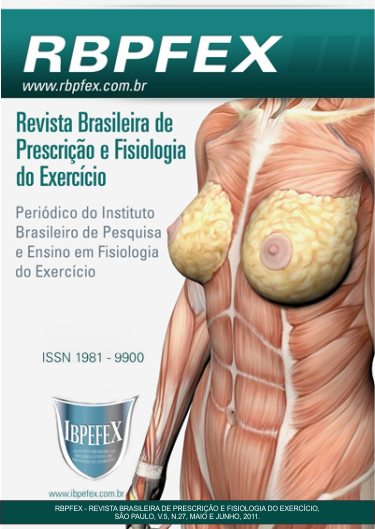Analysis of the effects of an of eight-weeks interruption at weight training on anthropometric indicators
Abstract
Introduction: The interest in exercise and health has been a cause for concern, making it an inexhaustible source of research. Objective: To analyze the effects of of an eight-week interruption at weight training on anthropometric indicators. Materials and Methods: The sample consisted of 10 men, bodybuildersand volunteers, aged between 29 and 62 years old (42.2 ± 11.2). The subjects underwent body weight (BW), abdominal circumference, skinfold thicknesses: triceps (TR) suprailiac (SI) and abdominal (AB) measurements. The Date were collected before and after the interruption. Results: BW were assessed beforethe interruption, averaging 76.89 ± 9.59 Kg and after 77.96 ± 10.06 p<0.01. BMI before the interruption was 25.77 ± 1.94 and after 26.22 ± 2.18 and p<0.01. Abdominal circumferencemeasurements were 91.26 ± 9.15 and, when they returned, measurements increased to 92.74 ± 9.84 and p<0.01. The sum of skinfold thicknesses: TR, SI, AB, 64.85 ± 24.43 were 69.74 ± 26.23 for p<0.05. Discussion: Significant differences were observed with the interruption of weight training, indicating that regular exercisingis the most important ally in maintaining body weight. Conclusion: The eight-week break in the weight training program results in a statistically significant increase in the anthropometric variables studied, demonstrating that it’s important for the health institutions, to invest in supervised physical exercising programs for the entire population, as a strategy for weight regulation, fighting the world pandemic of obesity.
References
-Azevedo, P.H.S.M.; Demampra, T.H; Oliveira, G.P.; Baldissera, V.; Burger-Mendonça; Marques, A.T.; Oliveira, J.C.; Perez, S.E.A. Efeito de 4 semanas de treinamento resistido de alta intensidade e baixo volume na força máxima, endurance muscular e composição corporal de mulheres moderadamente treinadas. Brazilian Journal of Biomotricity. Vol. 1. Num. 3. 2007. p. 76-85.
-Bouchard, C. Atividade física e obesidade. 1ª ed. São Paulo. Editora Manole. 2003.
-Carvalho, E.M.G.; Rabelo, J.N. Identificação, prevenção e tratamento dos fatores de riscos associados à síndrome metabólica em pacientes atendidos no programa integrado de atividade física, esporte e lazer para todos os servidores da UFV Campus Florestal: estudo piloto. Piafel-EP. SynThesis Revista Digital FAPAM. Pará de Minas MG, Num. 1, 2009.
-Ferreira, S.; Tinoco, A.L.A.; Panato, E.; Viana, N.L. Aspectos Etiológicos e o papel do exercício físico na prevenção e controle da obesidade. Revista de Educação Física. Viçosa MG. Num. 133. 2006. p. 15-24.
-Gomes, P.; Araujo, C.G.S. Há aumento do peso corporal nos finais de semana e nas festas de final do ano? Análise em participantes de programa de exercício supervisionado. Revista Brasileira de Medicina do Esporte. Vol. 10. Num. 3. Maio-junho, 2004. PP. 181-184.
-Guedes, D.P.; Guedes, J.E.R.P. Controle do peso corporal. Composição Corporal Atividade Física e Nutrição. 1ª Ed. Londrina. Midiograf, 1998. p. 25
-Guedes, D.P.; Guedes, J.E.R.P. Exercício na promoção da saúde. 1ª ed. Londrina. Midiograf, 1995.
-Lhoman, T.G.; Roche, A.F.; Martorrel, R. Anthropometrics standardization reference manual. Champaign, Illions, Human Kinetcs; 1988.
-Marques, J.M. Testes estatísticos: para cursos das áreas biológica e da saúde com uso do computador. Curitiba, Paraná. Domínio do Saber, 2004.
-Monteiro, A.M. Emagrecimento: exercício e nutrição. 1ª edição. Londrina. Midiograf, 2007.
-Nahas, M.V. Atividade física, saúde e qualidade de vida: conceitos e sugestões para um estilo de vida ativo. Londrina. Midiograf, 2001.
-Pauli, J.R. Efeitos do destreinamento e da dieta hiperlipídica nos mecanismos moleculares de indução de obesidade e resistência á insulina. Campinas, SP, s.n. Universidade Estadual de Campinas. 2007. p. 2-20.
-Santos, C.F.; Crestan, T.A.; Picheth, D.M.; Felix, G.; Mattanó, R.S.; Porto, D.B.; Segantin, A.Q.; Cyrino, E.S. Efeito de 10 semanas no treinamento com pesos sobre indicadores da composição corporal. Revista Brasileira de Ciência e Movimento. Brasília. Vol. 10. Num. 2. abril 2002. p. 79-84.
Authors who publish in this journal agree to the following terms:
- Authors retain the copyright and grant the journal the right of first publication, with work simultaneously licensed under the Creative Commons Attribution License BY-NC which allows the sharing of the work with acknowledgment of the authorship of the work and initial publication in this journal.
- Authors are authorized to enter into additional contracts separately for non-exclusive distribution of the version of the work published in this journal (eg, publishing in institutional repository or book chapter), with acknowledgment of authorship and initial publication in this journal.
- Authors are allowed and encouraged to post and distribute their work online (eg, in institutional repositories or on their personal page) at any point before or during the editorial process, as this can bring about productive change as well as increase impact and impact. citation of published work (See The Effect of Free Access).






